Moore Point development in Liverpool highlights how Sydney is changing forever
A major new development in a Sydney suburb will provide 11,000 new homes on a site the size of eight Melbourne Cricket Grounds.
The Moore Point development in Liverpool, in the city’s south-west, has moved a step closer to being given the green light after finally being put out for consultation after almost a decade of being mired in bureaucracy.
The project will transform an old industrial area along the Georges River into a mini river city. The dense, towering development will provide a blueprint for how the country can solve its critical housing shortage.
Residents can purchase their own slice of heaven in one of several glass apartment blocks on the 32-hectare site, which will also feature shopping malls, restaurants, cafes and bars, as well as parks and a purpose-built school for 1,000 students.
For comparison, the land on which the MCG stands, including the playing field, stadium and grounds, is 4.05 hectares.
Moore Point will see the removal of back gardens and garages in favour of balconies for those who can afford them, and public transport via a pedestrian walkway across the river to Liverpool’s business district and train station.
This new development and others like it could help the Australian government meet its goal of building an additional 1.2 million homes by July 2029, as the country tackles its housing shortage and skyrocketing house prices.
Building homes quickly and in the right place is a major problem. The latest projections from the Master Builders Association show that all states and territories are on track to miss the National Housing Accord targets. In total, there will be a shortfall of around 166,000 homes.
The Moore Point development in Liverpool, Sydney’s south-west, will house 11,000 new households in half a dozen towering apartment blocks
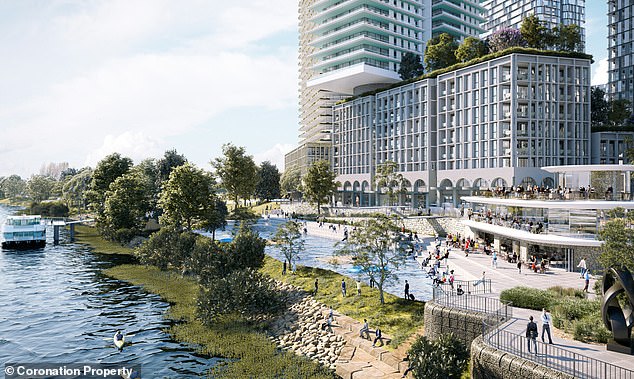
New ‘river city’ opens for public consultation for zoning rezoning after years of delays
Former New South Wales Premier Dominic Perrottet said Moore Point could become the “Barangaroo of the West”, referring to the major waterfront development in Sydney’s CBD just north of Darling Harbour.
In March this year, Moore Point developer Coronation Property wrote to new Premier Chris Minns threatening to pull out of the project after it had been held up for years due to flooding concerns, despite the fact that the site had never previously experienced major flooding.
The letter, published in The Daily Telegraph, was prompted by a new series of flood studies commissioned by the Planning Department, which would take another 18 months to complete.
“The current situation is no longer tenable and requires immediate certainty from the government,” Coronation wrote.
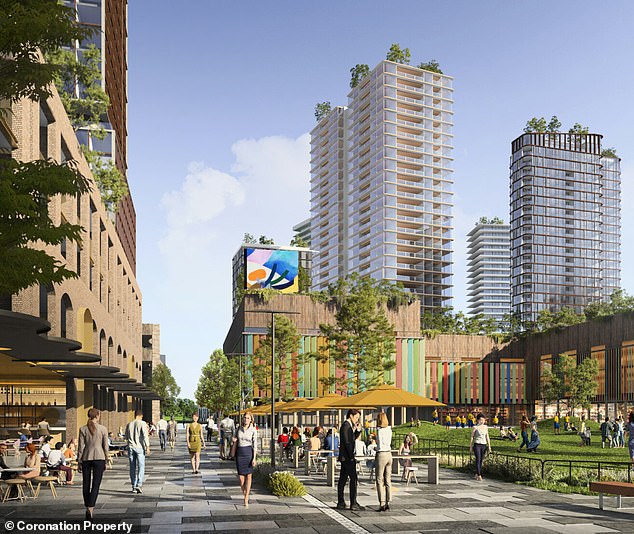
New South Wales Premier Chris Minns said Sydney “needs to expand” to provide housing rather than create more urban sprawl
The project is currently in the zoning plan amendment phase.
If approved, planning and construction approvals will still be required for each phase of the project.
Coronation has pledged that around 400 of the 11,000 homes will be affordable housing for frontline workers.
Coronation Director Joe Nahas said he was excited to see the project moving forward after such a long time.
“We are extremely pleased that after all the hard work on the project, including years of extensive consultation with our key stakeholders and the community, we can now move to the next step in the planning process,” said Mr Nahas.
‘We are proud that Moore Point will be the crown jewel of Sydney’s south-west and is poised to deliver 11,000 high-quality new homes in an area where the critical housing shortage is failing to meet the growing needs of the community.’
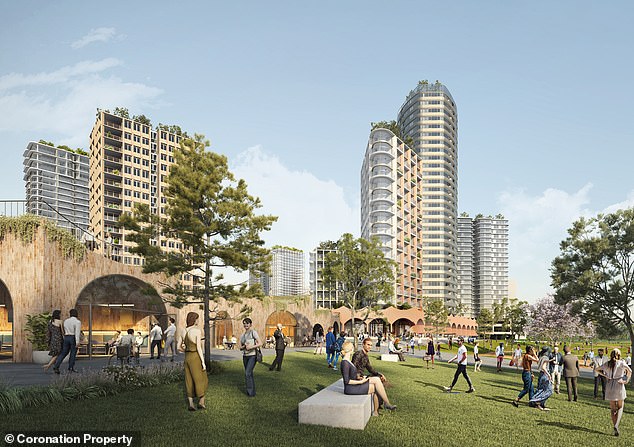
It is estimated that Sydney’s population will reach 6.4 million by 2041, requiring an additional half million homes
Between 1991 and 2021, the number of people living in apartments in Sydney more than doubled, with 30 percent of all Australians now living in apartment buildings.
Where once a three-bedroom house sat on 1,000 square feet, developers are now offering a tower of 30 40-square-foot studios, valued at more than $500,000. These studios are barely larger than a motel room.
And this despite the huge growth of new housing developments on the outskirts of the city, in suburbs such as Schofields in the west, Quakers Hill in the north-west and near Campbelltown in the south-west.
Sydney’s housing market is currently undergoing a radical revolution linked to the construction of homes along the city’s major transport routes.
Conventional housing and outdated low-rise blocks are making way for high-density developments emerging along the main roads to the north, west and south.
“We need to move up,” New South Wales Premier Chris Minns said earlier as he pledged his support for major new developments along the city’s public transport links.
‘Sydney can’t grow by adding a street every week to the western edge of Sydney. The best way… is to have buildings that go up.’
Many of these were built to accommodate the new underground station that has opened at Crows Nest and are also located on major bus routes along the Pacific Highway.
Their job is to ensure that residents can get from home to work within 15 minutes.
Video editor Jake Horne, 32, has no regrets about trading his garden house in Gosford on the Central Coast for a much smaller apartment on Sydney’s North Shore.

Video editor Jake Horne, 32, has no regrets about giving up his garden home in Gosford on the Central Coast for a much smaller apartment on the city’s north coast
“The commute was horrendous,” he told Daily Mail Australia as he relaxed in the green play area built directly above the railway line at the 88 Christie St precinct in St Leonards.
‘I was just tired of that long journey.’
“It would be nice to have a bigger apartment at some point. I’ve been in my house for four years now and it’s already worth $150,000 more than I paid for it, which is ridiculous.”
He said the old ideas about apartment complexes were being transformed by the new, architecturally inspired designs.
Pointing to the St Leonards development, he added: ‘These look a lot nicer than some of the silos you see in the older developments.
The story is similar along all of the city’s major roads, such as Mascot, Stanmore and Carlingford, with high-density apartment buildings along major routes and rail lines serving the city’s various business centres.
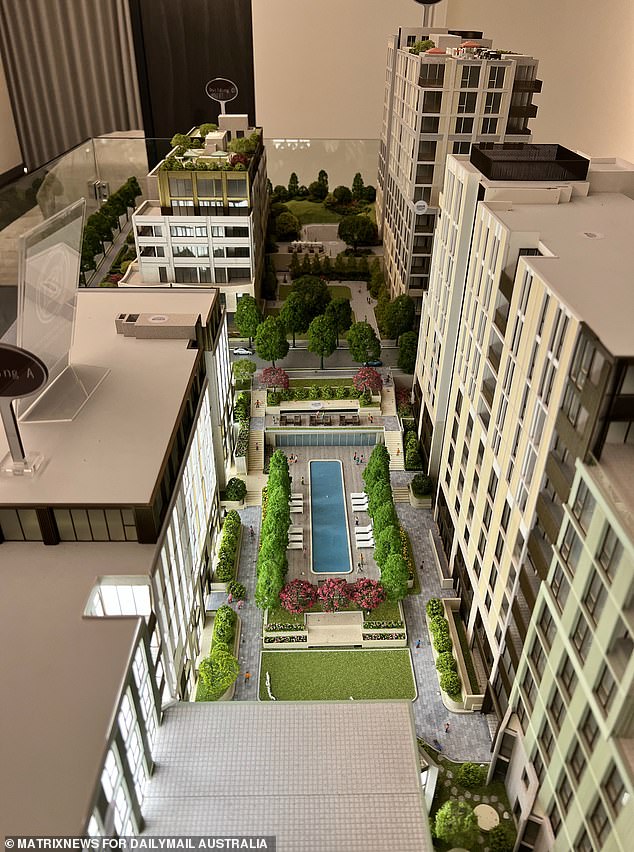
Developments like these (pictured is another Sydney project, St Leonards) provide a high-quality blueprint for Sydney’s future under the 15-minute city philosophy
And the biggest of all is the revitalised capital of western Sydney, Parramatta, which is barely recognisable from what it was 25 years ago.
Jo Main, 32, a mother of two, is a teacher and a big fan of the playground at St Leonards, but lives in a terraced house in nearby Crows Nest.
“We have two kids and are really outdoorsy people, so I don’t think we have enough space to store our gear,” she told Daily Mail Australia.
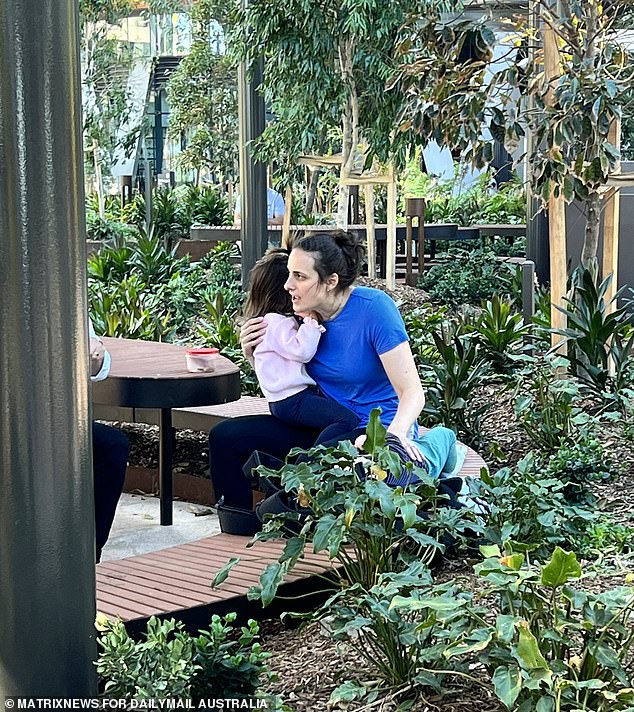
Mother-of-two teacher Jo Main, 32, (pictured) is a big fan of the children’s play area in her St Leonards neighbourhood.
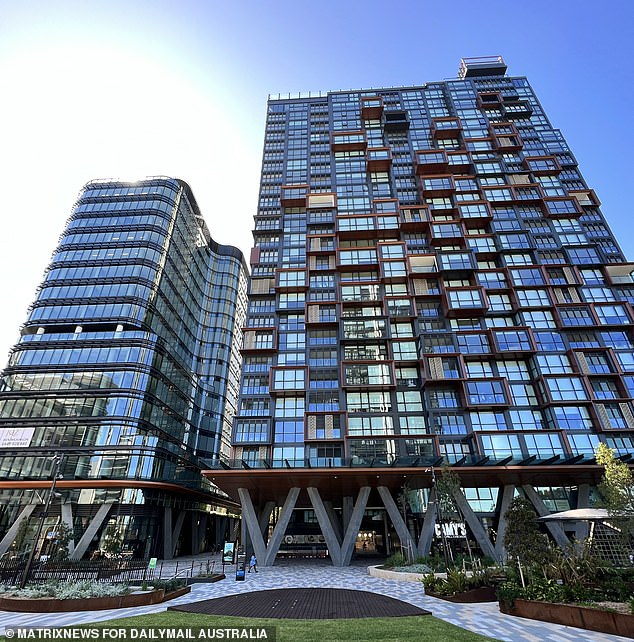
New tower blocks, up to 47 storeys high, around St Leonards on Sydney’s Lower North Shore are vertical villages, with supermarkets, medical centres and even libraries built into their design
‘Six years ago, many apartment complexes only had a storage space near your parking space, but you don’t need that to store strollers.
‘Even getting strollers through a doorway or into an elevator can be a challenge.’
But she added: ‘I love living in an apartment. I’ve lived in one before and I loved not having to worry about household chores like gardening or maintenance.
‘We only discovered the St Leonards development a few weeks ago and saw the shopping centre underneath and it’s incredible. It’s so impressive.
“It’s great because a lot of people need to live close to their work. And for people who work in the city, it’s a great solution: you have everything within reach.”
‘It’s fantastic, especially for people with children living in one of these apartments, that we have such a special playground.
‘But I worry that the high density of apartments could overcrowd local amenities, which were not designed for so many people, unless everything is expanded to meet demand.
“There are pros and cons. It has definitely added a lot to the value of our property because there are fewer houses in the area now and the demand is higher.”
